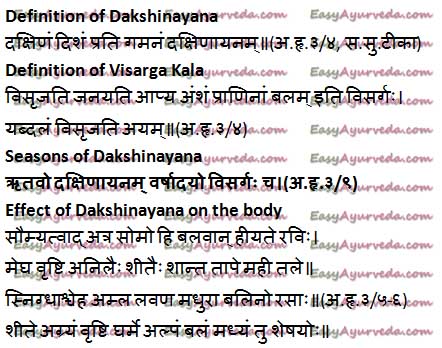Article by Dr Raghuram Y.S. MD (Ay) & Dr Manasa, B.A.M.S
Rutucharya is one of the beautiful concepts explained in Ayurvedic treatises. It deals with comprehensive management of one’s diet patterns, behavior and lifestyle management in relation to changing seasons. In short, Rutucharya is ‘Seasonal Regimen and rules and regulations related to what to do and what not during seasons and seasonal changes’.
According to Ayurveda, a calendar year is made up of two solstices –
Uttarayana (Adana Kala) or Northern Solstice and
Dakshinayana (Visarga Kala) or Southern Solstice.
Each Ayana is made up of 6 months. These 6 months are again divided into 3 seasons of 2 months each. Thus, each ayana comprises of 3 seasons which run a period of 2 months.
Read related: Uttarayana – Adana Kala (Northern Solstice) Definition, Seasons, Effect On Health

Table of Contents
Dakshinayana
Dakshinayana – Southern Solstice
Dakshinayana is that part of the year in which there is descent of the Sun. To be precise, in Dakshinayana, there is southward movement of the Sun.
The southward movement of the Sun and the ayana which gives strength to the person is called Dakshinayana.
Definition
The ayana which enhances aapyamsha (watery ingredients, moisture, fluidity) and strength of the living beings is called Visarga Kala.
Seasons of Dakshinayana
- Varsha Rutu – Rainy Season
- Sharat / Sharad Rutu – Autumn Season
- Hemanta Rutu – Winter Season
Effect on Earth and body
Effect of cooling effect of Visarga Kala on the Earth and on living beings
Since these seasons give strength to the human beings due to the reduction of heat, these three seasons are called Visarga Kala. This happens because, in these three seasons, the clouds, rain and cold wind prevailing in theses seasons take away the heat from the Earth caused by Adana Kala and makes it cool. The moon is predominant in the Visarga Kala.
Read related: Ritucharya – Healthy Seasonal Regimen – Introduction, Divisions
The winds are not very dry and fierce in these 3 seasons, but the moon is more powerful than the Sun. Snigdhata or Unctousness sets in the atmosphere. The sour, salt and sweet tastes are predominant in these seasons (these tastes are predominant in the food, plants, water and medicines). These 3 tastes tend to increase the strength of an individual and also are antagonistic to the effects of wind and fire (vata and pitta). These 3 rasas enhance the water content of the body, restores hydration and enhances the strength of the living beings.
Seasons of Visarga Kala
| Sl No | Season | Rasi (Zodiac) of the Sun | Saka varsa / masa (Hindu month) | Month | Predominant Rasa |
| 1 | Varsha
(Rainy, Monsoon) | Karkataka (Cancer)
Simha (Leo) | Shravana / Nabha
Bhadrapada / Nabhasya | July15 – Aug15
Aug15 – Sept15 | Amla (Sour) |
| 2 | Sharat
(Autumn) | Kanya (Virgo)
Tula (Libra) | Aashvija / Isha
Karthika / Urja | Sept15 –Oct15
Oct15 –Nov15 | Lavana (Salt) |
| 3 | Hemanta (Winter) | Vrischika (Scorpio)
Dhanus (Sagittarius) | Margashira / Saha
Pushya / Sahasya | Nov15– Dec15
Dec15 –Jan15 | Madhura (Sweet) |
Rutu, Strength and taste
Relationship between the Rutu, strength and predominant taste
| Rutu | Rasa | Panchabhuta | Bala (strength) |
| Varsha | Amla | Prithvi (Earth), Agni (Fire) | Alpa (less) |
| Sharad | Lavana | Ap / Jala (Water), Agni (Fire) | Madhyama (moderate) |
| Hemanta | Madhura | Prithvi (Earth), Ap (Water) | Uttama (very good) |
Other points of importance in relation to Visarga Kala –
- In the beginning of Visarga Kala i.e. in the Varsha Rutu – rainy season, the strength of an individual will be less (alpa bala)
- The living beings will have moderate strength (madhyama bala) in the middle part of Visarga Kala (madhyama bala) i.e. Sharad Rutu or Autumn Season
- At the end of Visarga Kala i.e. in the Hemantha Kala or Winter Season, the living beings will have good strength (Uttama Bala)
- In the Visarga Kala, the Moon will have its predominance. The universe is kept moist due to the smoothening and soothing rays of the Moon (Visarga).
- During Varsha Rutu, salty foods should be consumed.
- In Hemantha Rutu, sweet foods should be consumed.
- During Sharat Rtu, Madhura (sweet), Tikta (bitter) Kashaya (astringent) Rasas should be consumed
- In Sharat Rutu, Ruksha (dry) and Sheeta (cold) foods should be consumed.
- In Hemanta Rutu, Snigdha (unctuous) and ushna (hot) foods should be consumed.
- Vata Prakopa (aggravation) and Pitta Sanchaya (accumulation) take place in Varsha Rutu
- Pitta Prakopa and Vata Prashama (pacification) takes place in Sharad Rutu
- Kapha Chaya and Pitta Prashama takes place in Hemantha Rtu
Just Before Finishing
The knowledge of this will help us in leading a comfortable and healthy life through the 3 seasons comprising this half of the year. To have seasonal compatibility, we need to make small adjustments and get our dietetic and lifestyle practices in a right way blending in rhythm with each changing season.
Click to Consult Dr Raghuram Y.S. MD (Ayu) – Email / Skype









